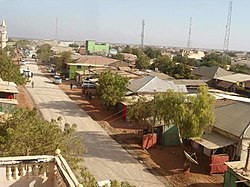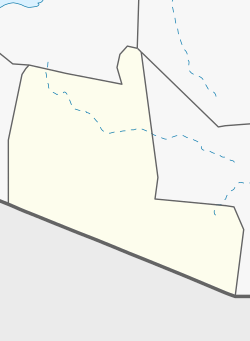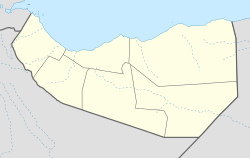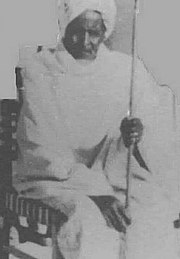| Revision as of 08:06, 24 March 2022 view sourceShirshore (talk | contribs)Extended confirmed users1,561 edits →GeographyTags: Mobile edit Mobile web edit← Previous edit | Revision as of 08:08, 24 March 2022 view source Shirshore (talk | contribs)Extended confirmed users1,561 edits →PoliticsTags: Mobile edit Mobile web editNext edit → | ||
| Line 77: | Line 77: | ||
| ==Politics== | ==Politics== | ||
| Buuhoodle is the capital of the ] region which was carved out of the ] region and encompasses the majority of ]. | |||
| In June 2014, the Puntland government launched a new tree-planting campaign in the state, with the regional Ministry of Environment, Wildlife and Tourism slated to plant 25,000 trees by the end of the year. Buuhoodle is among the 5 cities and towns earmarked for the reforestation initiative, which also include ], ], ], and ]. The campaign is part of a broader partnership between the Puntland authorities and EU to set up various environmental protection measures in the region, with the aim of promoting reforestation and afforestation.<ref name="Gswedcipgcftp">{{cite news|title=Somalia: World Environment Day celebrated in Puntland, Govt calls for tree plantation |url=http://www.garoweonline.com/artman2/publish/Somalia_27/Somalia-World-Environment-Day-celebrated-in-Puntland-Govt-calls-for-tree-plantation_printer.shtml |accessdate=6 June 2014 |agency=Garowe Online |date=5 June 2014 |url-status=dead |archiveurl=https://web.archive.org/web/20140606220447/http://www.garoweonline.com/artman2/publish/Somalia_27/Somalia-World-Environment-Day-celebrated-in-Puntland-Govt-calls-for-tree-plantation_printer.shtml |archivedate=6 June 2014 }}</ref> | In June 2014, the Puntland government launched a new tree-planting campaign in the state, with the regional Ministry of Environment, Wildlife and Tourism slated to plant 25,000 trees by the end of the year. Buuhoodle is among the 5 cities and towns earmarked for the reforestation initiative, which also include ], ], ], and ]. The campaign is part of a broader partnership between the Puntland authorities and EU to set up various environmental protection measures in the region, with the aim of promoting reforestation and afforestation.<ref name="Gswedcipgcftp">{{cite news|title=Somalia: World Environment Day celebrated in Puntland, Govt calls for tree plantation |url=http://www.garoweonline.com/artman2/publish/Somalia_27/Somalia-World-Environment-Day-celebrated-in-Puntland-Govt-calls-for-tree-plantation_printer.shtml |accessdate=6 June 2014 |agency=Garowe Online |date=5 June 2014 |url-status=dead |archiveurl=https://web.archive.org/web/20140606220447/http://www.garoweonline.com/artman2/publish/Somalia_27/Somalia-World-Environment-Day-celebrated-in-Puntland-Govt-calls-for-tree-plantation_printer.shtml |archivedate=6 June 2014 }}</ref> | ||
Revision as of 08:08, 24 March 2022
City in Togdheer, Somaliland| Buuhoodle بوهودله | |
|---|---|
| City | |
 | |
  | |
| Coordinates: 8°13′52″N 46°19′36″E / 8.23111°N 46.32667°E / 8.23111; 46.32667 | |
| Country | |
| Region | Togdheer |
| District | Buuhoodle |
| Population | |
| • Total | 83,747 |
| Time zone | UTC+3 (EAT) |
Buuhoodle (Template:Lang-so, Template:Lang-ar), also known as Bohotle, is the second largest city in the Togdheer region of Somaliland or under Puntland the largest city in the Cayn region. It is a prominent border town for movements of goods to and from Somaliland and the Somali Region of Ethiopia. The surrounding district is rich in both livestock and fledgeling agriculture.
Territorial dispute
Main article: Somaliland-Puntland disputeBuuhoodle which is the second most important city for the Dhulbahante after Las Anod is under the control of local unionist militia. Despite attempts the 2021 Somaliland parliamentary and municipal elections did not take place in the city.
The city is disputed by Puntland and Somaliland. The former bases its claim due to the kinship ties between the Dhulbahante clan and the dominant clan in Puntland, the Majeerteen. Whilst the later's claim is grounded on the border of the former British Somaliland Protectorate. The city was the de facto capital of Khatumo State throughout its existence until its dissolvement in 2017.
A conflict ensued in the vicinity of Buuhoodle between Somaliland and SSC Movement troops in 2010 and again in 2012. The conflict which became known as the Kalshale conflict was at first a clan skirmish but quickly escalated to involve the two administrations. The conflict was eventually resolved in early 2012, with the official withdrawal of Somaliland troops to a 50 km radius of the city's perimeter.
Geography
Physiographically, Buuhoodle is located in Ciid,and geopolitically, on the border between Somaliland and Ethiopia.
Politics
Buuhoodle is the capital of the Cayn region which was carved out of the Togdheer region and encompasses the majority of Buuhoodle District.
In June 2014, the Puntland government launched a new tree-planting campaign in the state, with the regional Ministry of Environment, Wildlife and Tourism slated to plant 25,000 trees by the end of the year. Buuhoodle is among the 5 cities and towns earmarked for the reforestation initiative, which also include Garowe, Bosaso, Qardho, and Galkayo. The campaign is part of a broader partnership between the Puntland authorities and EU to set up various environmental protection measures in the region, with the aim of promoting reforestation and afforestation.
History
Main article: Dervish movementDervish period
The Dervish Movement emerged in Buuhoodle and localities in its vicinity. According to a contemporaneous news report from The Marion Star, the Bah Ali Gheri, were the first people to adopt the Dervish identity; as such, making the Bah Ali Gheri onelings the founders of the Dervish:
By his marriage he extended his influence from Abyssinia, on the west, to the borders of Italian Somaliland, on the east. The Ali Gheri were his first followers.
— The Marion Star, rehash from British intelligence reports
The Bah Ali Geri, a clan in the to the south of Buuhoodle, were the people whom hosted the Sayid Mohamed during the fledgling moments of the Dervish in the 19th century:
"This Haji Muhammad Abdullah belongs to the Habr Suleiman Ogaden tribe; he married into the Dolbahanta Ali Gheri, amongst whom he now lives".
British intelligence reports also claimed that the Bah Ali Geri clan were the earliest or old allies of the Mad Mullah (Sayid Muhammad Abdullah Hassan):
"Mullah to flee eastwards and rejoin his old allies, the Ali Gheri, south of Bohotele, where he would be difficult to get at, either by the Abyssinians or ourselves".

In the oldest surviving work on Dervishes, Malcolm Mcneill states the two largest subclans in Buuhoodle, the Bah Ali Gheri and Ararsame were the main opponents of European colonialism:
The two principal offenders were the Ali Gheri and the Arasama tribes, who had for a long time made the whole Dolbahanta country unsafe for Europeans without a large escort; it was now time to settle with them once and for all.
— Malcolm McNeill
As a consequence of their anti-colonialism, 1200 Ararsame and Bah Ali Gheri clansmen were killed and their livestock embezzled:
The total number of casualties inflicted on the enemy at McNeill's zariba and in the subsequent pursuit in the Ararsamah and the Ali Gheri country, and at Ferdiddin, cannot have fallen far short of some 1,200 men killed ... The camels were either given as compensation to the Ishak tribes who had been looted by the Mullah or were handed over to the men, with their how disposed consent, in lieu of pay, thus reducing the cost of the expedition.
— McNeill
James Hayes Sadler stated that the primary base of Dervish support came from Buuhoodle:
Unless we can soon operate with Abyssinia to suppress the Mullah, I shall have to create a diversion by moving with available forces, supported by tribal levies, to punish tribes who are Mullah's principal supporters round Bohotele. This could be safely done, as the eastern Ishak tribes are friendly and united.
— Sadler
Eric Swayne stated that the people of Buuhoodle had "always proved to be the backbone" of adherence to Dervishnimo.
He had attempted to combine the Ogaden against Mersin for them, but these tribes having been badly treated by him, would not now help, and Dolbahanta on the punishment of one of their outlying sections by the Abyssinians, the Mullah found himself compelled to retire eastward to Bohotle to our Dolbahanta tribes, his own kinsmen, who have always proved to be the backbone of his following.
— Eric Swayne
Colonial perspectives
1912 was a tumultuous year for the Dhulbahante clans inhabiting Bohotle and the Ain valley. The clans of Bohotle being allies of the British Empire, were set upon and attacked by Hassan and his Dervish army, forcing them to evacuate and seek refuge in Burao, Berbera and Haud among the Isaaq clans. British colonial governor Horace Byatt reported that 800 Dhulbahante refugees arrived in Berbera, but feared that they could not be protected nor fed properly, stating that only 300 native infantry and 200 King's African Rifles were in Berbera and insufficient to hold off a Dervish attack. Byatt also raised concerns for the Dhulbahante refugees en route to British controlled territory and the possibility of them being looted by hostile clans, particularly the Habr Yunis.
Baron Ismay's intelligence report on the Dervish raids on the Bah Ali Gheri and the Dolbahanta clan's of Bohotle
No important move was made till November 1911, when he successfully attacked the Ali gheri at Bohotleh. He followed this up in February 1912 with an attack on the Dolbahanta at Eildab, In this engagement our people lost all their stock and were reduced to starvation. They flocked to Berbera demanding to be supported. Yet another attack on Bohotleh in March resulted in the remaining Dolbahanta in that vicinity being looted and driven out. Bohotleh remained in Dervish hands.
British colonial administrator Sir Douglas Jardine describing the plight of the Dhulbahante writes :
The most pitiful lot of all fell to certain sections of the Dolbahanta. Ousted from their ancestral grazing grounds by the Mullah's advance and bereft of all their stock, the remnants wandered like veritable Ishmaelites in the Ishaak country, deprived of Asylum and almost all access to the coast.
These conditions were not limited to the Dhulbahante only but encompassed the entire territory of British Somaliland Protectorate. The British retreat to coastal outposts left the interior country in a state of power vacuum that heralded a period acute distress, scarcity and violence that came to be known locally as Xaaraame Cune "time of eating filth". An estimated one third of the entire population of Somaliland perished during this period.
Economy
It serves as a commercial hub for the movement of goods to and from Bosaso, Garowe, Las Anod, Galkayo, Wardheer, Burao, the surrounding area, and the Ogaden.
Demographics
As of 2014 the broader Buuhoodle District had a estimated population of 83,747 residents. Buuhoodle is primarily inhabited by people from the Somali ethnic group, with the clan eponyms of Ararsame and Bah Ali Gheri of Dhulbahante especially well-represented.
Education
Buuhoodle has a number of academic institutions. According to the Puntland Ministry of Education, there are 12 primary schools, 3 high schools and 2 universities in the Buuhoodle District. Among these are H/dh Abu-Bakar Sadiq, H/dh Al-Najax, H/dh Al-Furqan and so on. Secondary schools in the area include Howd and Samatar Bahman.
For health education, there is Buhodle College Of Health Science.
For higher studies, Buuhoodle is served by the East Africa University (EAU). The institution opened a seventh branch in the town on 18 April 2012 to serve pupils from the Cayn region.
Notable residents
- Abdihakim Abdullahi Haji Omar – Vice President of Puntland
- Mohammed Abdullah Hassan – Leader of the Dervish
- Saado Ali Warsame – Singer & MP in the Federal Parliament of Somalia
- Ismail Mire - Somali poet and Dervish movement general
- Ali Dhuh - Somali poet
- Saleban Essa Ahmed 'Xaglatoosiye' - Somaliland Minister of Health & former SSC militia leader
Notes
References
- Kluijver, Robert (2020). "The State in Somaliland". Sciences Po Paris: 4. Retrieved 13 March 2022.
- Hoehne, Markus V. (2015). Between Somaliland and Puntland: Marginalization, Militarization and Conflicting Political Vision. Rift Valley Institute. p. 109. Retrieved 21 September 2019.
- "A Vote for Change: Somaliland's Two Decades Old Electoral Democracy" (PDF): 11.
{{cite journal}}: Cite journal requires|journal=(help) - "Averting War in Northern Somalia". International Crisis Group. 27 June 2018. Retrieved 31 January 2019.
- Mahmood, Omar (2019). "Overlapping claims by Somaliland and Puntland: The case of Sool and Sanaag" (PDF). Institute for Security Studies: 7. Retrieved 29 May 2021.
- "What is Khatumo? A Special Report on SSC region of Northern Somalia". Somali Report. 2012. Retrieved 12 June 2021.
- "Dagaal ka dhacay Buuhoodle". BBC News Somali (in Somali). 2012-01-15. Retrieved 2021-04-15.
- "Somalia: Former Militia Leader Joins Somaliland Cabinet". Garowe Online. 14 October 2012. Retrieved 15 October 2012.
- Issa, Jama (1974). Taariikhda Daraawiishta. p. 32.
Shiikh Cabdille Xasan wuxuu ku dhashay dhulka loo yaqaan Ciid-Nugaaleed ama Laaso oo ah degmada Buuhoodle
- "Somalia: World Environment Day celebrated in Puntland, Govt calls for tree plantation". Garowe Online. 5 June 2014. Archived from the original on 6 June 2014. Retrieved 6 June 2014.
- "The Marion Star from Marion, Ohio on April 30, 1903 · 7".
- Parliamentary Papers: 1850-1908 - Volume 48 - Page 1
- Colonial Postscript: The Diary of a District Officer - Page 130, Patricia Morley, 1992
- In Pursuit of the Mad Mullah; Service and Sport in the Somali Protectorate , 1902, Malcolm McNeill
- Official History of the Operations in Somaliland 1901 - 04, 1907
- Das Staatsarchiv: Sammlung der offiziellen Aktenstücke zur Aussenpolitik der Gegenwart ..., Volumes 65-66
- Sessional Papers - Volume 69 - Page 27, Great Britain. Parliament. House of Commons · 1902
- Irons, Roy (4 November 2013). Churchill and the Mad Mullah of Somaliland: Betrayal and Redemption 1899-1921 p.147. ISBN 9781783463800.
- "King's College London, King's collection : Ismay's summary as Intelligence Officer (1916-1918) of Mohammed Abdullah Hassan".
- The Mad mullah of Somaliland, p.158
- McCall, Daniel F. (1969). Eastern African History.
- Bulhan, Hussein Abdullahi (1999). A Self-portrait of Somaliland: Rebuilding from the Ruins. p. 12.
- Lewis, I. M (1965). The Modern History of Somaliland. Weidenfeld & Nicolson. p. 77.
- Kluijver, Robert (2020). "The State in Somaliland". Sciences Po Paris: 4. Retrieved 13 March 2022.
- Hoehne, Markus V. (2015)
- Diedrich Westermann, Edwin William Smith, Cyril Daryll Forde (2009). Africa, Volume 79, Issue 2. Oxford University Press. p. 266.
{{cite book}}: CS1 maint: multiple names: authors list (link) - "Puntland - Primary schools". Ministry of Education of Puntland. Retrieved 26 May 2013.
- "Puntland - Secondary schools". Ministry of Education of Somalia. Retrieved 26 May 2013.
- "Buhodle Campus". East Africa University. Retrieved 19 March 2014.